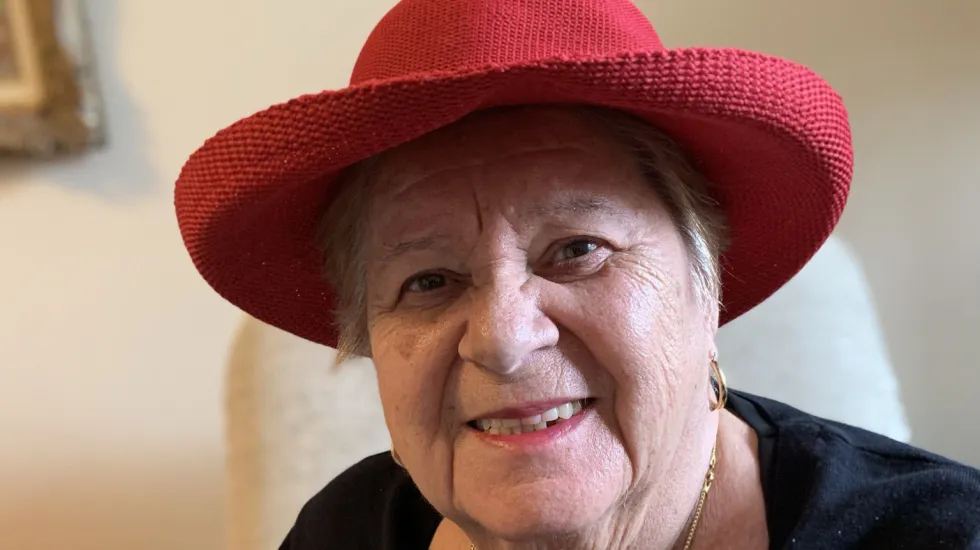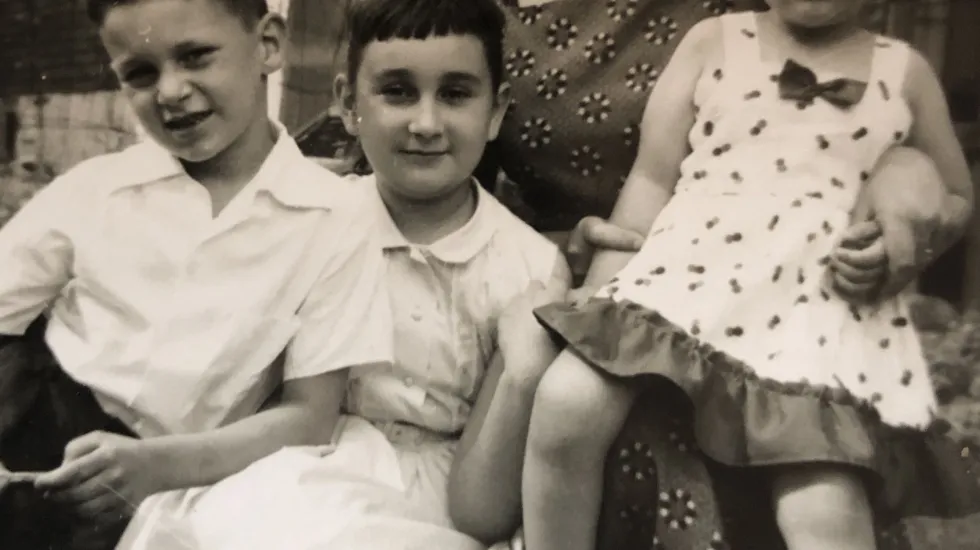
Golda “Goldie” Indig spoke six languages and could urge you to nosh in all of them.
Eat, eat, she’d tell family and friends, serving up homemade chicken soup, schnitzel, blintzes and latkes.
“ ‘Your soup is getting cold,’ my bubbie would say to me — right as she put the plate down,” her grandson Scott Randel said in a eulogy.
Feeding her family was a triumph over the past for Mrs. Indig, who suffered hunger in three Nazi prison camps during World War II.
She first cheated death at Auschwitz, thanks to a big coat and her quick-thinking mother Henia. When they stumbled out of the cattle car that brought them to the concentration camp, her mother saw people being separated into two lines. One was filled with elderly and sick prisoners or small children — people who couldn’t work.
Henia’s older children — son Mechel and daughter Blimchu — were sent to the line of the young and strong.
Henia removed her coat and slipped it to 13-year-old Goldie, who, for the rest of her life, remembered her mother’s next words: “Wear the big coat so you look older.’ ”
“Her mom was trying to make her look a little older, taller, bigger,” said Mrs. Indig’s granddaughter Brooke Randel. “Her mom knew in that moment what was happening.”
Little Goldie was sent to the line of strong, young people. Her mother and her two smaller siblings — sister Rojha Blima, 8, and brother Meilekh, 11 — were ordered into the other line.
She never saw them again.
“Took them to the crematorium,” she said in an oral history she gave about the Holocaust in 1997.

Mrs. Indig went on to survive two more death camp “selections.”
After liberation, she married and immigrated to Canada, then the United States. In Detroit, she worked for General Motors for 31 years, driving a forklift and sewing leather seats for Cadillacs. Later, she cleaned offices.

Mrs. Indig never learned to read or write. She could only sign her own name because she had just a few years of schooling. Yet she spoke Yiddish, Hungarian, Romanian, German, Hebrew and English.
She got her driver’s license by taking an oral test and would navigate by landmarks.
Over the years, she used her GM discount to purchase several Cadillacs, one of them white, one silver.
At 86, “Goldie started working out,” her granddaughter said. “She would do the machines for 30 minutes at Mather Place” of Wilmette, where she died April 28 at 91.
Her granddaughter said she liked her apartment at the senior residence, but “she said everyone there was old.”
Mrs. Indig lived long enough to be a great-grandmother for 19 years. She and her husband Benti, also a Holocaust survivor, raised three kids — a doctor, a nurse and an engineer.
Thanks to her pension, investing in property and buying and selling jewelry, Mrs. Indig helped relatives whenever she could, her daughter said — sometimes with a car purchase; sometimes by adding them to her health insurance.
“She bought a word processor from Canada and drove it into the States” so a grandchild would have it for college, Randel said.
When Randel was starting out on her own, her grandmother bought a couch for her apartment.
“I hope you love it,” Mrs. Indig told her. “You’re gonna think of me when you sit down!”

When her granddaughter Rebecca Feldman was small, a doctor feared she might have jaundice because of her skin’s orange tint.
“What does a doctor know?” her grandmother said.
It turned out her bubbie had been pureeing lots of carrots and adding them to her chicken soup.
She always had a home remedy, which she’d administer while saying, in Yiddish, “How it comes is how it should go.” She’d feed relatives blueberries soaked in vodka for “anything that bothered you, especially a sore throat,” her daughter Hedi Bednarz said.
When a baby was born, Bednarz said, Mrs. Indig would put red ribbons all over the crib to protect against evil.
One time, she sheltered a victim of domestic violence at her Detroit home.
“I remember the husband was banging on the door,” her daughter Gail Randel said.
Mrs. Indig never opened it.
After retiring, she first lived in Florida, where she faithfully took her cousin Helen Stein — who nursed her back to strength in Romania after the war — to the hairdresser.
Young Goldie was born in the former Czechoslovakia and spent her early years in a Romanian town once called Sighet, the birthplace of writer and fellow Holocaust survivor Elie Wiesel. Her father Peretz Feuerwerger dealt in cattle.
After being taken to Auschwitz, she survived a second selection when “a capo, a prisoner with some power, pulled her out” of a group who were to be killed, according to Brooke Randel.
Later, after a third selection, “I was too skinny and little,” Mrs. Indig said in the oral history. She remembered being told she “should go to the crematorium. And that gave me strength when I saw somebody looking away, I sneaked behind the building, and I run to my sister [Blimchu], to the other side of the group.”
They were then sent to Kristianstad, a German labor camp. Because she’d been selected for death at Auschwitz, officially she didn’t exist. So she dodged authorities, sometimes hiding in latrines or the camp kitchen, where she peeled vegetables and smuggled an occasional carrot to her older sister.
Some prisoners prayed for Allied bombers to finish them off.
“I remember a lady had a [stillborn] baby,” Mrs. Indig said in her testimony about Kristianstad. “She said, ‘Thank God, it’s dead. I don’t have to kill it.’ ”
Mrs. Indig and other prisoners were then sent on a six-week march to the concentration camp Bergen-Belsen. Sometimes, she later recalled, “People throw bread at us from the window, they seen us starving and dragging. And who picked it up got shot.”

She was 14 when British forces liberated Bergen-Belsen. At 16, she married Benti Indig, whom she’d met in Sighet. They immigrated to Canada, where they lived for 13 years while he operated Ben’s Coffee Shop. Then, they moved to Detroit, where he drove a taxi.
In her later years at Mather Place, she enjoyed vanilla ice cream from Culver’s and playing the tile game Rummikub.
Mrs. Indig loved having visitors. “You could see it in her face, when you walked in to the room, it would light up,” Feldman said.
Mrs. Indig’s father died when she was 7. In addition to the deaths of her mother Henia and siblings Meilekh and Rozha Blima at Auschwitz, her brother Bumme is believed to have been shot by fascists after he survived a WWII labor camp in Hungary. Her brother Mechel, also held in Bergen-Belsen, died shortly after liberation. Her sister Blimchu Milszstein settled in Israel, where she died in 2002.

In 1988, her husband went to Romania to erect headstones to honor his parents, who died in the Holocaust. He died of a heart attack on the plane flying home.

Services have been held.
Mrs. Indig is also survived by her son Harry, five more grandchildren and six great-grandchildren.
She wanted people to never forget about the Holocaust.
“Some people say it never happened,” Mrs Indig said. “How can they say that? They killed so many people.”
Golda Indig’s crescent roll cookies
Golda Indig’s grandmother Malka taught her to make crescent roll cookies around 1935. Her family calls them “a nutty delight — .equal parts buttery, flaky and sweet.”
Ingredients — Dough
• 4 cups flour
• 1 lb. butter, softened
• 4 egg yolks
• ¾ pint sour cream (or 16 oz. cream cheese)
Ingredients — Filling
• 1 package walnuts, chopped (10 oz.)
• 1 cup sugar
• 4 egg whites
Directions
1. Mix flour, butter, yolks and sour cream to form dough. Leave in the refrigerator overnight.
2. Combine walnuts, sugar and egg whites to make the filling.
3. Roll out the dough with flour, and cut into triangles three or four inches long.
4. Spoon the walnut filling onto the base of each triangle. Roll dough to cover the filling. Keep going until the whole cookie is rolled up.
5. Bake at 400 degrees, seam side down, for 15 minutes or until the crescent rolls “have a light golden-brown color and are impossible to resist,” her family says.
Golda Indig’s blintzes (palacsinta)
Ingredients
• 1 cup flour
• 2 eggs
• 1 tsp. sugar
• Pinch of salt
• Butter
• Farmer’s cheese
• Jam, preserves or curd (optional)
Directions
1. Combine flour, eggs, sugar and salt to create a thin batter. (Recipe can be doubled or tripled as needed.)
2. Heat and butter pan. Pour in a small amount of batter to create a thin, even circle. Let cook for one or two minutes, until golden, then flip. Set aside once cooked. Repeat until there’s no more batter.
3. Scoop farmer’s cheese onto one edge of the blintz and roll. Jam, preserves or curd can be added inside or on top. Serve hot or cold.
Golda Indig’s potato latkes
The quantities given are estimates. Goldie Indig’s family says she “was not one for measuring. Watch the batter. If it’s dry, add liquid. If it’s runny, add oatmeal.”
Ingredients
• 5 potatoes, peeled — Yukon Gold or whatever’s on hand
• 1 large onion
• 4 eggs
• 2½ tbsp.s oatmeal (or ½ tbsp. per potato)
• 1 tsp. salt
• ¼ tsp. pepper
• 1⁄3 cup oil
Directions
1. Grate potatoes and onion into a large bowl. “Try not to nick your finger.”
2. Add the eggs, oatmeal, salt and pepper to the mix, and stir.
3. Heat oil. Form the mixture into thin, round patties, and cook until crispy, flipping halfway through.
4. When latkes are golden brown, move to a plate with a paper towel. Blot the grease, and serve immediately.
Golda Indig’s ‘creamish’
Note: The Hungarian name for this dessert is krémes.
Ingredients — Pastry dough
• 4 cups flour
• 1 lb. butter
• 4 egg yolks
• 16 oz. sour cream
Ingredients — Custard filling
• 3 vanilla pudding mixes (3 oz. each)
• 6 cups whole milk
• 2 tbsp. cornstarch
• 1 tsp. vanilla extract
Directions
1. To make the dough, knead flour and softened butter. Gradually add egg yolks and sour cream. Add flour if the dough is too sticky. Roll into a ball, cover, and refrigerate overnight.
2. Coat saucepan with butter. Add 4 cups of milk. Bring to a simmer.
3. Mix 1 ½ cups of cold milk with pudding mixes, then add to the heated milk.
4. In a separate bowl, mix ½ cup of milk with the cornstarch, then add to the heated milk.
5. When a few bubbles appear in the heated milk, add vanilla, and remove the pan from the stove.
6. Cover saucepan with plastic wrap, and refrigerate overnight.
7. Take the dough from the fridge, and let soften.
8. Preheat oven to 400 degrees. Place parchment paper on two cookie sheets.
9. Cut dough in half. Roll it out to the size of a cookie sheet, and place it on top of the parchment paper. Repeat.
10. Cook dough 5-10 minutes. Remove from the oven when the pastry is a light golden color. Let cool completely.
11. Place pudding filling on one of the pastry sheets. Slide the second pastry sheet over top.
12. Sprinkle powdered sugar generously. As Goldie Indig’s family puts it: “A little more. A little more, still. More. Refrigerate until ready to serve.”







